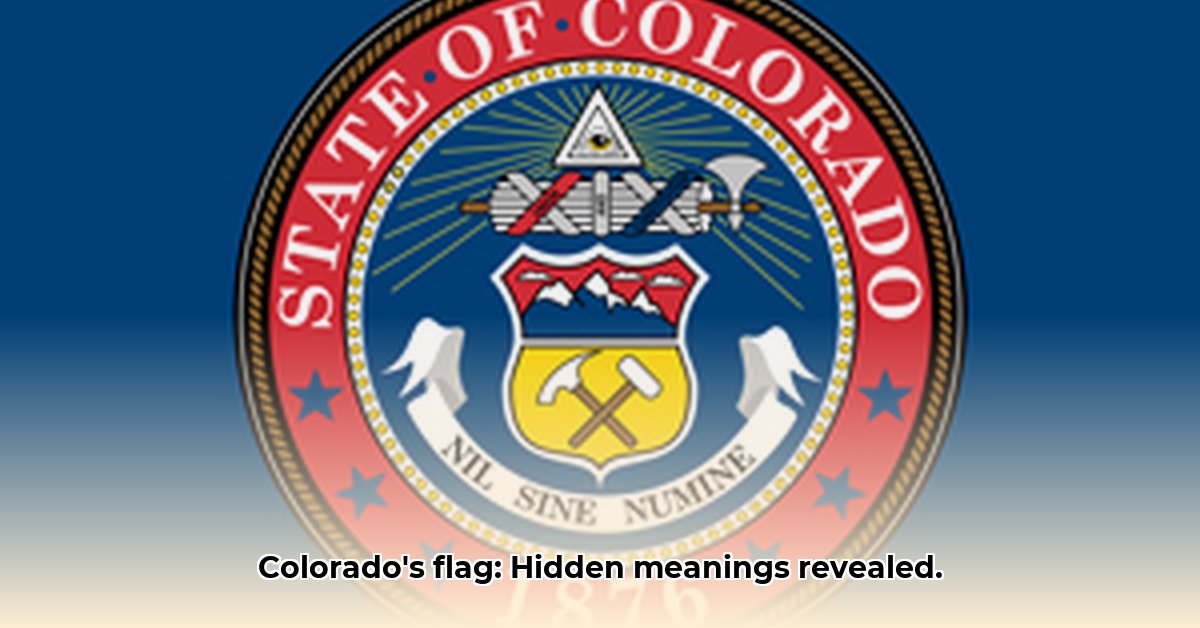Ever stopped to consider the story behind that striking blue, white, and gold flag waving proudly across Colorado? It’s far more than just a pretty design; it’s a captivating narrative etched in color and symbol, reflecting the state’s rich history and vibrant spirit. This article delves into the fascinating journey of Colorado’s flag, from its conceptual beginnings to the iconic emblem it is today, revealing the secrets behind its colors, debating the symbolism, and exploring its evolving identity. For comparison, check out other state flags like the Kentucky flag.
Colorado Flag’s Rich History and Enduring Symbolism
A Simple Design, a Surprisingly Rich History of Colorado
At first glance, the Colorado flag’s design seems elegantly simple: three horizontal stripes – blue, white, and blue – bisected by a bold red “C” embracing a golden disk. But beneath this simplicity lies a captivating story, a tapestry woven with design revisions, varying interpretations, and ongoing debates. Officially adopted on June 5, 1911, the flag we recognize today embodies artistic choices, governmental decisions, and the pulse of public opinion across the years. It stands as a representation of Colorado’s breathtaking landscapes, its significant mining legacy, and its centennial celebration. However, aspects of its meaning remain open to interpretation, adding to its allure. Did you know that, while initially approved in 1911, the flag’s design saw further clarifications on February 28, 1929, regarding color shades and again on March 31, 1964, concerning the “C” and gold disk specifications?
Decoding the Design: Unpacking the Colors and Shapes
A general consensus surrounds the colors’ primary meanings. The deep blue mirrors Colorado’s expansive sky, the bright white embodies the snow-capped mountains, and the radiant yellow-gold signifies the state’s abundant sunshine. However, the striking red “C” opens pathways to varying interpretations. While most believe it represents “Colorado,” alternative possibilities exist. Some suggest it symbolizes Colorado’s centennial celebration, marking the state’s admission to the Union in 1876, the same year as the United States’ centennial. Others propose a subtle nod to the state flower, the Columbine. The gold and white may also represent the state’s gold and silver mining industries, respectively.
From Sketches to Standard: The Flag’s Formative Journey
The Colorado flag wasn’t conceived overnight. The state initially adopted a flag on April 9, 1907, featuring parts of the state seal and the state motto “Nil sine numine”. Deemed unpopular, only one such flag was ever produced and it remained unused in a capitol building closet. The design we recognize today began with a meeting of the Denver chapter of the Daughters of the American Revolution (DAR) on November 14, 1910. Andrew Carlisle Carson’s design was favored over an earlier proposal. Significant revisions occurred on February 28, 1929, refining the colors to match those of the national flag, followed by adjustments on March 31, 1964, that optimized the size and placement of the “C” and golden disk. This evolution illustrates how a symbol can be refined and enhanced over time. Notably, the Daughters of the American Revolution played a role in the early design stages, highlighting the extent of public engagement in crafting this iconic symbol. “The Colorado state flag’s specifications were not defined until 1929, which led to various interpretations of the flag,” reveals the Colorado State Archives.
Symbolism and Mystery: Unraveling the Secrets of the “C” and Centennial State Nickname
Within Senate Bill 118, which passed the Colorado Senate on May 6, 1911, ten specific points of symbolism were laid out. The red “C” stands for three things: the name of the state, “Colorado”, the word “centennial”, referring to Colorado’s accession to statehood in 1876, the year of the United States’ centennial; and “columbine”, referring to the state flower. The gold disk in the center of the “C” represents not only the sunshine the state receives (which totals nearly 300 days annually), but also gold and the gold mining industry in the state. The blue stripes represent the sky, and the white stripes represent both the peaks of the Rocky Mountains and silver, as well as the resulting mining industry; the blue and white stripes together also represent the colors of the columbine flower. Other symbolism apart from the senate bill has been noted, including the red coloring of the “C” standing for the “ruddy” earth that covers much of the state’s terrain. The flag is laid out in a 2:3 ratio, specifically with “a width of two-thirds of its length”.
Colorado’s Beauty Versus its Mining History: Nature vs. Legacy
Another engaging point of discussion revolves around the balance between Colorado’s natural splendor and its mining heritage. Does the gold color solely represent sunshine, or does it also symbolize the state’s rich mining history, which played a pivotal role in its early prosperity? This duality captures Colorado’s complex identity. The integration of these elements into the flag’s symbolism underscores the challenges of encapsulating an entire region within a single design.
A Cherished Symbol, Yet Subject to Scrutiny
While the Colorado flag holds a special place in the hearts of many Coloradans, it hasn’t escaped criticism. In a 2001 survey by the North American Vexillological Association, Colorado’s flag was ranked sixteenth, with a score of 6.83. However, the ongoing conversations and fresh interpretations surrounding its symbolism underscore its enduring significance and its capacity to spark diverse opinions regarding Colorado’s identity. Could a flag truly capture the essence of an entire state without sparking some level of debate?
The Future of the Flag: An Ever-Evolving Symbol of Colorado
What does the future hold for the Colorado flag? Further exploration into its origins and symbolism will likely deepen our understanding. Educational initiatives could promote greater awareness of its rich history and meaning. It’s crucial to remember that the Colorado flag is a dynamic symbol, constantly evolving and reflecting the ever-changing nature of Colorado itself. The narrative of our state flag continues to unfold.
Unveiling the Colorado Flag: How Did the 1929 Revisions Affect Its Symbolism?
The Colorado state flag, a seemingly simple symbol, encapsulates a rich history of revisions, debates, and evolving interpretations. Let’s embark on a journey to uncover the impact of the 1929 changes on its symbolism.
A Simple Design, Complex Meaning: Standardizing the Centennial State
At first glance, the flag is easy to understand: three horizontal bands of blue, white, and blue, with a red “C” and a golden disc in the center. But what do these elements really represent, and how did the 1929 standardization affect those representations? The colors typically symbolize Colorado’s landscape – the blue sky, the snow-capped mountains, and the red earth. However, the meaning of the “C” and the golden disc remain subjects of ongoing discussion. Some see the “C” as representing Colorado itself, others, as a nod to the Centennial State, chosen because Colorado became a state in 1876, when the country was celebrating the centennial of its independence. The golden circle is often interpreted as the state’s abundant sunshine or its rich mineral wealth, but there’s no official consensus. Is it possible for a single symbol to fully capture the spirit and history of a diverse state like Colorado?
The 1929 Revisions: A Turning Point in Colorado History
The initial design, adopted in 1911, lacked precise specifications. This ambiguity led to inconsistencies in the flag’s appearance across the state. The 1929 amendments addressed these inconsistencies, standardizing that the blue and red would be the same colors as those found on the national flag. This standardization, while seemingly minor, had a profound impact. It created a unified visual identity for the state, ensuring consistent representation, reinforcing the flag’s symbolic power. The precise details became integral to the flag’s meaning, transforming it from a loosely defined concept into a precisely rendered emblem.
The Impact of Standardization: A Unified Visual Representation
Before 1929, variations in the flag’s appearance diluted its symbolic impact. Each differently colored or proportioned flag carried its own subtly altered message. The 1929 revisions corrected this. A unified visual representation strengthened the flag’s ability to convey its intended message. It fostered a stronger sense of shared state identity and pride. Think of it like this: a poorly reproduced painting loses its impact. The revisions sharpened the focus, making Colorado’s flag a clearer, more potent symbol.
Ongoing Debates and Interpretations of Colorado’s Flag
Even with the 1929 amendments, interpretations of the flag’s symbolism continue to evolve. There is no single, universally agreed-upon meaning for every detail. This ongoing debate adds another layer of depth and interest to the story of the flag. It reflects the diversity of perspectives within Colorado and keeps the flag relevant in the present. “The flag design is intended to reflect the beauty of Colorado,” says [Dr. Emily Richards], [Professor of Colorado History] at the [University of Colorado Boulder]. “However, the meaning and interpretation are constantly evolving.”
Key Insights:
- The 1929 revisions to the Colorado state flag were crucial
- Unveiling ancient roman busts: Values, history, & decor tips. - August 18, 2025
- Unlock Ancient Glamour: Roman Hairstyles, a Recreation Guide for Today’s Style Icons - August 18, 2025
- Rome’s Visual Legacy: Finding Authentic Ancient Rome Images and Pictures Today - August 18, 2025
















